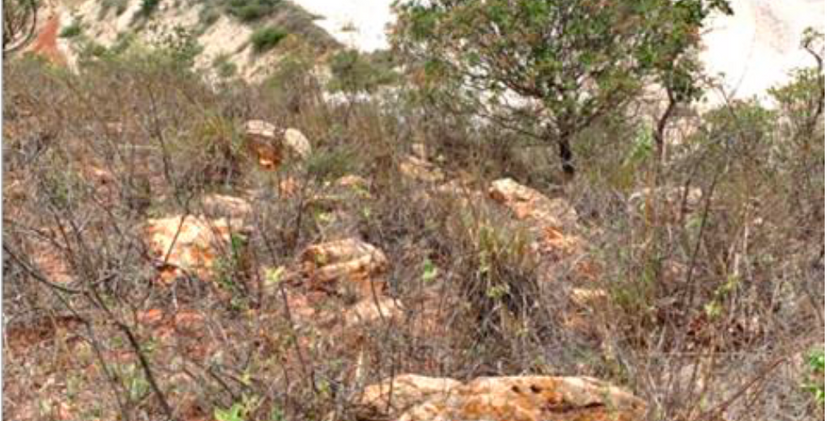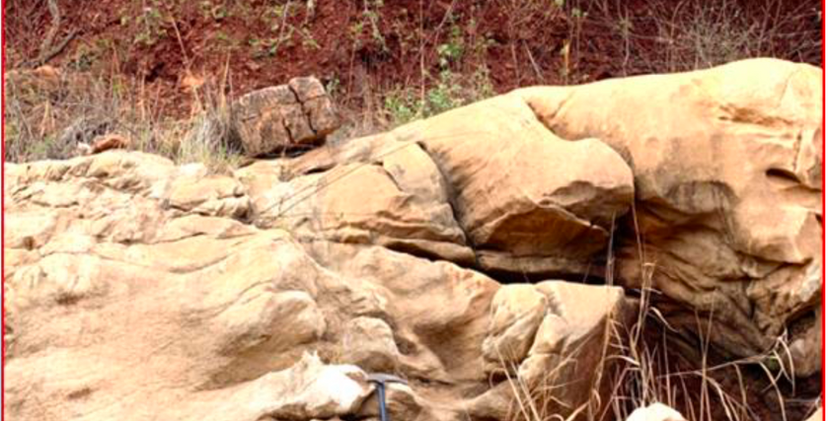Magnesite
Brumado - BA
The area of mining process no. 870.963/2021 occupies 171.96ha and is located in the municipality of Brumado, Bahia, Brazil.

HIGHLIGHTS

Tune in to our exclusive podcast showcasing the Magnesite deposit in Brumado, Bahia.
LOCATION AND LOGISTICS
The mining process area No. 870.963/2021 covers 171.96 hectares and is located in the municipality of Brumado, Bahia.
The access from the nearest city (Brumado) to the visited area is 13 km, via a well-maintained road comprising 4 km of asphalt and 9 km of well-maintained dirt road. It is important to note that the entire dirt road segment is maintained by the companies IMI FABI and RHI Magnesita, which produce talc and magnesite from mines located on the same mountain range as the ANM process area visited.
Brumado is located approximately 540 km from the state capital, Salvador, Bahia.

Fig 1. Local geology with rolling mesh and identified lithologies.

Fig 1. Geographical Location of the Visited ANM Process
Brumado offers excellent infrastructure in its urban center, providing robust support for mining projects of all sizes. The city features accommodations such as hotels and inns, workshops, restaurants, banks, quality medical services, and other relevant and positive aspects that make it well-suited for industrial and mining activities.
GEOLOGICAL CONTEXT AND REGIONAL MINERAL POTENTIAL
Regionally, the visited process is situated within a Granite-Greenstone geological context, specifically associated with the Brumado Greenstone Belt (GB Brumado), located in the southern sector of the Gavião Block, São Francisco Craton.
The ANM process 870.963/2021 covers roughly 172 hectares over the Serra das Éguas, the main metavolcanic-sedimentary rock belt among the three subdivisions of the Brumado Greenstone Belt. This highlights an interesting preliminary potential due to the presence of large talc and magnesite deposits in the vicinity.
Granite rocks and gneiss-migmatites are also found in the macro-region, though they have less relevance to the mineral potential of the visited area.

Fig 2. Regional geology highlights the distribution of the Brumado Greenstone Belt and the gneiss-migmatites of the crystalline basement, which are the main regional influences in the area.
As described, the Brumado Greenstone Belt represents the most significant geological unit for a positive metallogenic potential in the area. In this regard, the main lithotypes of the lower, middle, and upper sequences exposed in the Serra das Éguas, where the visited ANM process is located, are as follows.
-
Lower Sequence: Ultramafic komatiitic flows, serpentized, tremolitized, and talcified, with narrow bands of BIF (banded iron formation), succeeded by mafic toleitic flows, amphibolitized, and horizons of calc-silicate rocks and felsic schists (bitotite and garnet).
-
Middle Sequence: Felsic schists (metatuffs / metapelites / metavolcanics), cherts, and quartzites.
-
Upper Sequence: A succession of metasediments represented by metacarbonates, quartzites, and BIFs. This sequence includes limestone, dolomite, and magnesite deposits.
REGIONAL MINERAL OCCURENCES.
Figure 3 below, illustrates the large number and frequency of talc and magnesite occurrences and deposits in the evaluated region, which have been cataloged by CBPM (Bahian Company of Mineral Research) and CPRM/SGB (Geological Service of Brazil).
Other substances occur within the same geological context; however, they do not exhibit significant volume or quality like the aforementioned minerals.
The operations of IMI FABI (talc extraction) and RHI Magnesita (magnesite extraction) in the same mountain range and geological context further confirm the presence of a highly positive regional mineral potential for the ANM process in question.

Fig 3. Regional Mineral Occurrences Cataloged by CBPM and CPRM in the State of Bahia. Highlight to the very large volume of magnesite and talc concentrated in the study area, located to the west of Brumado (Serra das Éguas).
In addition to the substances mentioned above, the field visit revealed evidence of rocks that may indicate potential interest in other occurrences in the area, such as quartzite and quartz, which will be discussed in the following chapter.

Fig 4. Talc and magnesite mining operations are active in the macro-region of the visited area. Notably, all extractions occur within the same topography, known as Serra das Éguas.
LOCAL GEOLOGY
The field survey aimed to identify the most representative geological units on a regional scale but within the mining process area. Combined with pre-existing data, this allowed for the interpretation of the local mineral potential.
In this context, 21 points were visited in the field, subdivided into "control" and "outcrop" categories. At these points, descriptions of the materials found, structural geology, interpretation of topography/relief/drainage, soil analysis, and sample collection were conducted.

Fig 6. Map showing the locations of data collection points for geological reconnaissance.
CRYSTALLINE BASEMENT ZONE – GNEISSES.
Outcrops of rocks from this unit are frequent in the central sector of the visited process area, but they do not exhibit high mineral potential due to their compositional characteristics. These rocks are mostly stretched gneisses (with variations to augen gneisses) aligned along a local NNE/SSW trend ranging from N205° to N175°. They form structural contacts with other lithotypes of the metasedimentary unit of the Brumado Greenstone Belt, such as quartzites and calc-silicate rocks.
The cataloged outcrops can essentially be described as:
Crystalline rocks with high-grade penetrative foliation, composed of biotite, quartz, feldspars/plagioclase, and ferromagnesian minerals. They commonly feature quartz veins and narrow quartz stringers, particularly near contacts with adjacent units, indicating increased associated deformation.

Fig 7. Examples of outcrops from the crystalline basement unit, central sector of the visited ANM process.
METASEDIMENTS ZONE (BRUMADO GB)
When interpreted alongside regional geological information, it is possible to infer that the field data represent all three stratigraphic sequences of the Brumado Greenstone Belt (lower, middle, and upper), as a wide variety of lithotypes were identified.
This delineated unit presents the highest mineral potential in the area, justified by its metavolcano-sedimentary Greenstone nature (notably evidenced by metallic features observed in the field, such as the presence of manganese and iron metallic oxides) and metasedimentary rocks like well-recrystallized quartzites.
Based on these observations, the main lithotypes identified during the geological reconnaissance are as follows:
-
Calc-silicate rocks, characterized by a greenish color, very fine grain, and the presence of oxides in fracture planes. Foliated rock and quite representative within the unit.
-
Quartzites and metarenites ranging from white to gray, with associated quartz veins and levels of chert present (likely between lithotype transition zones).
-
BIFs (iron formations) present in a more localized manner, primarily consisting of metarenites/quartzites with thin laminations of hematite-rich layers. However, macroscopically, these rocks do not show significant potential for iron ore due to their volume/dimensions and modal composition with a high sterile/ore ratio.
This unit is where the talc and magnesite extractions are located in the region, further demonstrating that these lithotype intercalations and their alterations provide greater mineral fertility within the Serra das Éguas.
In the northeastern sector of the polygon, for example, points were visited that demonstrated high potential for magnesite.
FINAL CONCLUSIONS
ABOUT THE GEOLOGY AND IDENTIFIED MINERAL POTENTIAL, it can be concluded that:
-
The region of the study area presents good mineral potential given the geological characteristics of the Brumado Greenstone Belt and Serra das Éguas..
-
The metasediment unit is the most promising, containing occurrences of metals, quartzites, and magnesite.
ABOUT THE STRATEGIC POINTS, it is important to highlight that:
-
The logistics for the potential extraction operation in the area are very favorable, given the existing infrastructure of roads, water, and energy, due to the active operations of the talc and magnesite mines nearby.







